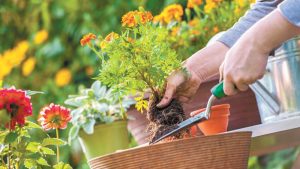June 29, 2017
The Art of Gardening
 By Mary Schricker Gemberling
By Mary Schricker Gemberling
“We come from the earth, we return to the earth, and in between we garden.”
Every spring, our suburban yard would come alive with color. The tulips and jonquils would push through the soil and explode in vibrant colors. The buds on the forsythia bushes at the corner of our modest brick bungalow would turn to delicate yellow flowers and the branches of the pussy willow, my favorite of all, would fill with the soft cotton like nubs. As spring turned into summer, my childhood home would become a showplace of trees and flowers. My mother, who loved to garden, shared her passion with me, and I, in turn, did the same with my two sons. When they were toddlers I would have them sitting next to me on the ground placing the delicate annuals in the freshly dug holes in the landscaping. My older son pursued a career in landscaping and still works in an agricultural related field. And I am guessing it won’t be too long before my younger son has one or more of his children, helping plant his garden! Since retirement and a move back to the country, I now have plenty of time and space to tend to my gardens. In the words of Claude Monet, “My Garden is my most beautiful Masterpiece of art”!
I have never questioned why I gardened; it just seemed to be a way of life for me. But an article I recently read explained the many benefits that gardening has for our mental and physical well- being.
 Gardening activities provide both cardio and aerobic exercise. Studies show that an hour of moderate gardening can burn up to 300 calories for women and 400 for men. From walking behind a mower, bending and stretching, planting and trimming, and hauling plants and soil, gardening provides a kind of cardiovascular workout. Strength, endurance, and flexibility are all improved by gardening, making it one of the best all-around exercises, helping to reduce the risk of heart disease, obesity, diabetes, and osteoporosis.
Gardening activities provide both cardio and aerobic exercise. Studies show that an hour of moderate gardening can burn up to 300 calories for women and 400 for men. From walking behind a mower, bending and stretching, planting and trimming, and hauling plants and soil, gardening provides a kind of cardiovascular workout. Strength, endurance, and flexibility are all improved by gardening, making it one of the best all-around exercises, helping to reduce the risk of heart disease, obesity, diabetes, and osteoporosis.
The therapeutic benefits of gardening have been recognized since humans first cultivated plants, but there is now a growing professional practice linking gardening to numerous, wide-ranging mental health benefits. ‘Horticultural Therapy’ is based on the physical, mental and emotional healing that is possible from regular interaction with a garden. It is successfully used in a variety of situations and is useful in helping people with special needs, the elderly, and those who have mental health problems.
Gardeners who grow their own plants or vegetables are more likely to eat a wider range of fruit, vegetables, salad and herbs than non-gardeners. Eating a wide variety of fruits and vegetables is essential to a healthy diet. Those gardeners who raise their own herbs and use them in cooking are one step ahead. The use of herbs in cooking reduces the need for salt and other seasonings that are linked to high blood pressure and other serious medical conditions.
Gardening is a great activity to share with your children and grandchildren. Not only is it a healthy change from the sedentary, and electronic world that consumes our young people but students who actively engage in designing, planting and maintaining a garden, show improved attitudes towards education and significantly higher scores on achievement tests especially in the area of science.
A garden provides an oasis of calm in this mad, mad world; a personal, private and peaceful place to escape to, from time to time when we need to restore a sense of balance and wellbeing. The term “garden”, which is of Germanic origin, means “yard” or “enclosure” and denotes ways of organizing earth, water, plants, as well as people, animals, and art.
It is so much easier to enjoy life when surrounded by flowers, vegetables, and all the wildlife they attract. Gardening provides an outlet for creative and artistic expression. It fosters confidence as there are no mistakes in gardening, only experiments. It cultivates patience, gives us hope, and strengthens our faith as we wait for that seed or plant to sprout and our barren earth to become a canvas of vibrant and varied colors. Charles A Miles explains it best in the following hymn:
In the Garden
I come to the garden alone
While the dew is still on the roses
And the voice I hear falling on my ear
The Son of God discloses.
Refrain
And He walks with me, and He talks with me,
And He tells me I am His own;
And the joy we share as we tarry there,
None other has ever known.
He speaks, and the sound of His voice,
Is so sweet the birds hush their singing,
And the melody that He gave to me
Within my heart is ringing.
Refrain
I’d stay in the garden with Him
Though the night around me be falling,
But He bids me go; through the voice of woe
His voice to me is calling
Refrain
“ He who plants a seed beneath the sod and waits to see the plants believes in God.”
Mary Schricker Gemberling, a former educator, and Seniors Real Estate Specialist is the author of three books, The West End Kid, Labor of Love; My Personal Journey Through the World of Caregiving and Hotel Blackhawk; A Century of Elegance.
Filed Under: Community, Featured, Personal Growth, Retirement
Trackback URL: https://www.50pluslife.com/2017/06/29/the-art-of-gardening/trackback/


